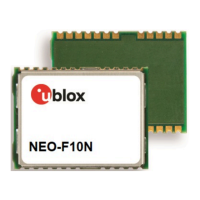
Do you have a question about the Ublox NEO-F10N and is the answer not in the manual?
| Concurrent Reception | Yes |
|---|---|
| Assisted Starts | 2 s |
| Velocity Accuracy | 0.05 m/s |
| Heading Accuracy | 0.3 degrees |
| Time Accuracy | 20 ns |
| Dimensions | 12.2 x 16.0 x 2.4 mm |
| GNSS Support | GPS, GLONASS, Galileo, BeiDou |
| Frequency | L1 |
| Interface | UART, SPI, I2C |
| Operating Temperature | -40°C to 85°C |
| Current Consumption | 25 mA |
| Protocols | NMEA, UBX |
Provides an overview of the NEO-F10N module's features and capabilities.
Details the receiver's architecture and key functionality, including the block diagram.
Details the pin assignment and functionality of the NEO-F10N module.
Summarizes common receiver configurations, including LNA modes and GNSS signal settings.
Covers configuration options for the navigation engine, including dynamic platforms and filters.
Details UART and PIO interfaces, including specific pins like RESET_N and LNA_EN.
Explains different receiver reset types (cold, warm, hot) and their effects.
Describes continuous and backup operating modes, including hardware and software standby.
Explains the VCC and V_BCKP power supply pins and their functions.
Covers RF input design, LNA modes, and out-of-band interference immunity.
Provides guidelines for PCB layout, grounding, and component placement for optimal performance.
Details critical safety precautions, including ESD protection and handling guidelines.
Describes module packaging, reels, tapes, moisture sensitivity, and soldering procedures.
Provides instructions on cleaning the module, warning against water, solvents, and ultrasonic methods.
Discourages repeated reflow soldering or upside-down soldering of the module.
Discusses wave soldering for base boards with THT components and modules.
Advises against using hot air guns for rework and recommends cleaning pads after module removal.
Explains the impact of conformal coating on RF properties and voids warranty.
Recommends specific silicon pottants for casting and advises qualifying processes.
Discusses grounding attempts and u-blox's warranty for damages from soldering metal strips.
Describes important differences and considerations when migrating from u-blox M8 to u-blox F10.
Provides specifications and recommendations for external components used in reference designs.
Lists recommended values for external components like capacitors, resistors, inductors, and transistors.
